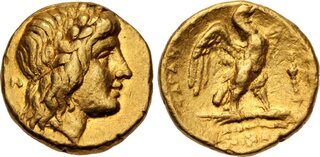Lot description:
CALABRIA, Tarentum. temp. Pyrrhos of Epeiros. Circa 276-272 BC. AV Quarter Stater – Triobol (11mm, 2.15 g, 4h). Head of Apollo right, wearing laurel wreath; NK monogram to left / Eagle standing right, wings spread, on thunderbolt; TAPAN[TINΩN] up left field; to right, [ΦI(?) above two stars] above two amphorai; NIKAP in exergue. Fischer-Bossert G58c (V49/R58 – this coin); Vlasto 57 (same dies); HN Italy 986; SNG Copenhagen 837 (same dies); Berlin 28 (same dies). Minor marks, double struck on reverse. VF.
Ex Gorny & Mosch 207 (15 October 2012), lot 15; Hess-Leu [22] (4 April 1963), lot 14; Leu FPL [1] (ND [1960]), no. 4.
This gold issue from Tarentum was struck during the time of Pyrrhos of Epeiros's campaigns in Italy. In the early 3rd Century BC, the Tarentines were at war with the Romans. To defeat their superior enemies, they decided that they needed the help of a powerful ally (Pausanias 1.12.1). So they sought the help of Pyrrhos, who crossed the Adriatic Sea in 280 BC. According to Pausanias, his reasons for joining the war were threefold. For one, the Tarentines had assisted him in his war with Korkyra, sending their fleet to augment Pyrrhos' forces. Secondly, Pyrrhos was enticed by the assertion of the Tarentine envoys that the land of Italy was prosperous and bountiful. The final, and perhaps most important, reason was that Pyrrhos "remembered the capture of Troy, which he took to be an omen of his success in the war, as he was a descendant of Achilles making war upon a colony of Trojans" (Pausanias 1.12.1).
Plutarch relates a wonderful anecdote that as Pyrrhos was deciding whether or not to help the Tarentines, he was counseled by his advisor Kineas (Plutarch, Pyrrhus, 14.2-7). Kineas asked his ruler what they should do if they succeed in conquering the Romans, and Pyrrhos replied that they would then conquer all of Italy. When asked by Kineas, "What then?", Pyrrhos replied that he would then move on to capture Sicily. The conversation proceeded in this way, until Pyrrhos said that they would eventually conquer the entire world. Kineas then asked what they should do once all of their foes were vanquished, to which Pyrrhos said, "We shall be much at ease, and we'll drink bumpers, my good man, every day, and we'll gladden one another's hearts with confidential talks" (14.6). Finally Kineas's point became clear when he said, "Then what stands in our way now if we want to drink bumpers and while away the time with one another? Surely this privilege is ours already, and we have at hand, without taking any trouble, those things to which we hope to attain by bloodshed and great toils and perils, after doing much harm to others and suffering much ourselves" (14.7). Though this logic made him uneasy, Pyrrhos continued with his expedition to Italy.
Though Pyrrhos was successful in his battles against Rome, the losses he sustained diminished his forces to the extent that he could not capitalize on his victories, so he was eventually forced to retreat back to Greece. This situation of tactical victory at a crippling cost is to what the expression "Pyrrhic victory" refers. Appropriately, after his victory over Rome at the battle of Asculum in 279 BC, Pyrrhos remarked, "If we are victorious in one more battle with the Romans, we shall be utterly ruined" (Plutarch, Pyrrhus, 21.9).
Estimate: 2000 USD |  |